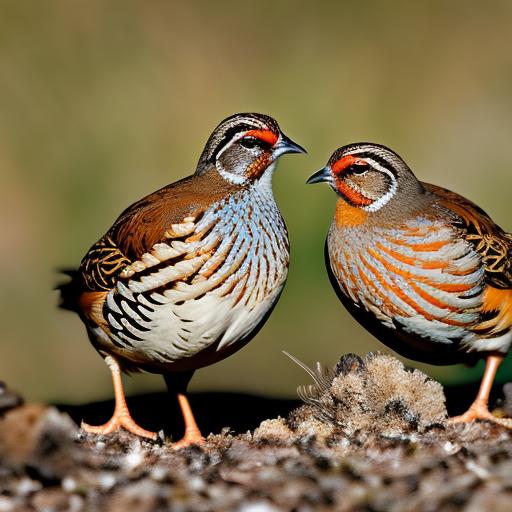Quails are small, ground-dwelling birds that belong to the pheasant family. There are several different breeds of quail, each with its own unique characteristics and traits. Some of the most popular quail breeds include the Coturnix quail, Bobwhite quail, Gambel’s quail, and California quail. Each breed has its own distinct coloration, size, and egg-laying capabilities. For example, the Coturnix quail is known for its prolific egg-laying abilities, while the Bobwhite quail is prized for its delicious meat. Understanding the differences between quail breeds is essential for anyone looking to keep mixed quail breeds together.
Quail breeds also vary in terms of their behavior and temperament. Some breeds are more docile and easy to handle, while others may be more skittish and prone to flight. It’s important to consider the temperament of different quail breeds when deciding which ones to keep together. Additionally, some quail breeds are better suited for certain climates and environments than others. For example, the Gambel’s quail is native to the desert regions of the southwestern United States and may not thrive in colder, wetter climates. By understanding the unique characteristics of each quail breed, you can make informed decisions about which breeds are compatible and how to best care for them.
Key Takeaways
- Quail breeds vary in size, color, and egg production, with popular breeds including Coturnix, Bobwhite, and Button quail.
- Different quail breeds can be compatible if introduced at a young age and provided with enough space and hiding spots in the enclosure.
- Housing different quail breeds together requires careful observation for signs of aggression and separate feeding areas to prevent competition.
- A balanced diet for mixed quail breeds includes commercial quail feed, fresh greens, and occasional treats like mealworms or fruits.
- Health considerations for mixed quail breeds include regular parasite control, access to grit for digestion, and monitoring for signs of common diseases like coccidiosis.
- Breeding and reproduction of mixed quail breeds can result in hybrid offspring, so breeders should carefully plan and separate breeding groups if purebred offspring are desired.
- Tips for successfully keeping different quail breeds together include providing ample space, monitoring for signs of stress or aggression, and seeking advice from experienced quail breeders.
Compatibility of Different Quail Breeds
When it comes to keeping different quail breeds together, compatibility is a key consideration. While some quail breeds can coexist peacefully, others may be more aggressive or territorial and may not do well in mixed flocks. It’s important to research the compatibility of different quail breeds before attempting to keep them together. In general, quail breeds that are similar in size and temperament are more likely to get along well. For example, Coturnix quail are known for their peaceful nature and can often be kept together in mixed flocks without issue.
On the other hand, some quail breeds, such as the Bobwhite quail, may be more aggressive and territorial, making them less suitable for mixed flocks. Additionally, it’s important to consider the gender ratio when keeping different quail breeds together. In most cases, it’s best to keep a higher ratio of females to males to prevent aggression and fighting among the males. By carefully selecting compatible quail breeds and maintaining the right gender ratio, you can create a harmonious mixed flock that coexists peacefully.
Housing Different Quail Breeds Together
When housing different quail breeds together, it’s important to provide adequate space and accommodations to meet the needs of each breed. Quails are social birds that thrive in flocks, so it’s essential to provide enough space for them to move around and establish their own territories. Additionally, different quail breeds may have varying space requirements based on their size and activity levels. For example, larger breeds like the Bobwhite quail may require more space than smaller breeds like the Coturnix quail.
It’s also important to consider the housing environment when keeping different quail breeds together. Quails are ground-dwelling birds that prefer open spaces with access to shelter and protection from predators. Providing a secure coop or aviary with plenty of hiding spots and perches can help reduce stress and aggression among different quail breeds. Additionally, it’s important to provide separate nesting areas for each breed to prevent competition for nesting sites and potential conflicts. By carefully planning and designing the housing environment, you can create a safe and comfortable living space for mixed quail breeds.
Feeding and Nutrition for Mixed Quail Breeds
Feeding and nutrition are critical considerations when keeping mixed quail breeds together. Different quail breeds may have varying dietary needs based on their size, activity level, and egg-laying capabilities. It’s important to provide a balanced diet that meets the nutritional requirements of all the quail breeds in your flock. A high-quality commercial game bird feed can serve as a base diet for mixed quail breeds, supplemented with fresh greens, fruits, and protein sources such as mealworms or crickets.
It’s also important to consider the feeding habits of different quail breeds when providing food and water. Some breeds may be more aggressive feeders and may require multiple feeding stations to prevent competition and ensure all birds have access to food. Additionally, providing clean water at all times is essential for maintaining the health and well-being of mixed quail breeds. By carefully monitoring feeding behaviors and providing a balanced diet, you can ensure that all the quail breeds in your flock receive the nutrition they need to thrive.
Health Considerations for Mixed Quail Breeds
Maintaining the health of mixed quail breeds requires careful observation and proactive management. Different quail breeds may have varying susceptibility to certain diseases and health issues, so it’s important to be vigilant in monitoring the overall health of your flock. Regular health checks, including observing behavior, examining droppings, and checking for signs of illness or injury, can help identify potential health concerns early on.
Additionally, providing a clean and sanitary living environment is essential for preventing disease outbreaks among mixed quail breeds. Regularly cleaning and disinfecting the coop or aviary, providing fresh bedding, and practicing good hygiene can help reduce the risk of illness and promote overall health. It’s also important to quarantine new birds before introducing them to an existing flock to prevent the spread of disease. By staying proactive in monitoring and maintaining the health of mixed quail breeds, you can help ensure a thriving and resilient flock.
Breeding and Reproduction of Mixed Quail Breeds

Breeding and reproduction are natural behaviors in mixed quail breeds that require careful management and planning. Different quail breeds may have varying reproductive behaviors and egg-laying capabilities, so it’s important to understand the breeding dynamics of each breed in your flock. Providing suitable nesting areas with clean bedding and privacy can encourage natural breeding behaviors among mixed quail breeds.
It’s also important to consider the genetic diversity of mixed quail breeds when breeding for desirable traits such as egg production or meat quality. Careful selection of breeding pairs based on traits such as size, coloration, and temperament can help maintain genetic diversity and produce healthy offspring. Additionally, providing proper nutrition and supplemental lighting can help stimulate egg production in mixed quail breeds.
Managing brooding and raising chicks is another important aspect of breeding mixed quail breeds. Providing a safe and warm brooding area with access to food and water is essential for ensuring the health and survival of young chicks. By carefully managing breeding and reproduction in mixed quail breeds, you can help maintain a sustainable and productive flock.
Tips for Successfully Keeping Different Quail Breeds Together
Successfully keeping different quail breeds together requires careful planning and management. Here are some tips for creating a harmonious mixed flock:
1. Research compatibility: Before introducing different quail breeds, research their compatibility based on size, temperament, and gender ratios.
2. Provide adequate space: Ensure that your housing environment provides enough space for all the quail breeds in your flock to establish their own territories.
3. Monitor feeding behaviors: Observe feeding habits and provide multiple feeding stations to prevent competition for food.
4. Maintain good hygiene: Regularly clean and disinfect the coop or aviary to prevent disease outbreaks among mixed quail breeds.
5. Monitor health regularly: Conduct regular health checks to identify potential health concerns early on and take proactive measures to maintain overall health.
6. Plan breeding carefully: Consider genetic diversity and desirable traits when breeding mixed quail breeds to maintain a sustainable flock.
By following these tips and staying proactive in managing different quail breeds together, you can create a thriving and harmonious mixed flock that coexists peacefully while meeting their unique needs and characteristics.
If you’re considering keeping different breeds of quail together, it’s important to understand the compatibility and potential challenges. To learn more about creating a suitable environment for your quail, check out this insightful article on converting a shed to a chicken coop. Understanding the principles of coop design and management can help ensure the well-being of your quail flock.
FAQs
Can you keep different breeds of quail together?
Yes, it is possible to keep different breeds of quail together in the same enclosure.
What should I consider before keeping different breeds of quail together?
Before keeping different breeds of quail together, it is important to consider the size of the enclosure, the compatibility of the breeds, and the potential for aggression or bullying.
What are the potential challenges of keeping different breeds of quail together?
Potential challenges of keeping different breeds of quail together include aggression between the different breeds, potential for hybridization, and the need to provide appropriate housing and resources for each breed.
How can I minimize potential issues when keeping different breeds of quail together?
To minimize potential issues when keeping different breeds of quail together, provide ample space and hiding spots, monitor the quail for signs of aggression, and be prepared to separate them if necessary.
Are there any benefits to keeping different breeds of quail together?
Keeping different breeds of quail together can provide variety in appearance and behavior, and may also help to prevent inbreeding within a single breed.
Meet Walter, the feathered-friend fanatic of Florida! Nestled in the sunshine state, Walter struts through life with his feathered companions, clucking his way to happiness. With a coop that’s fancier than a five-star hotel, he’s the Don Juan of the chicken world. When he’s not teaching his hens to do the cha-cha, you’ll find him in a heated debate with his prized rooster, Sir Clucks-a-Lot. Walter’s poultry passion is no yolk; he’s the sunny-side-up guy you never knew you needed in your flock of friends!







